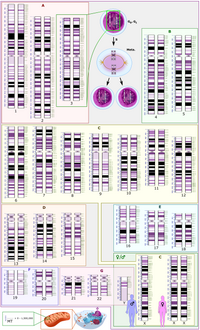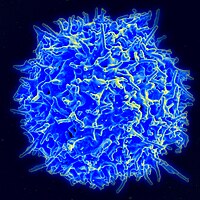
Structural flexibility of human α‐dystroglycan
Sign Up to like & getrecommendations! Published in 2017 at "FEBS Open Bio"
DOI: 10.1002/2211-5463.12259
Abstract: Dystroglycan (DG), composed of α and β subunits, belongs to the dystrophin‐associated glycoprotein complex. α‐DG is an extracellular matrix protein that undergoes a complex post‐translational glycosylation process. The bifunctional glycosyltransferase like‐acetylglucosaminyltransferase (LARGE) plays a crucial… read more here.
Keywords: flexibility human; murine; flexibility; structural flexibility ... See more keywords

Generation and Analysis of Human and Murine Osteoclasts
Sign Up to like & getrecommendations! Published in 2019 at "Current Protocols in Immunology"
DOI: 10.1002/cpim.74
Abstract: Osteoclasts are the only bone‐resorbing cells in the body. Together with bone‐forming osteoblasts, they are responsible for bone homeostasis and constant bone remodeling. Aberrant activation of osteoclasts leads to bone loss, as seen in postmenopausal… read more here.
Keywords: murine; generation analysis; analysis human; generation ... See more keywords

Inhibitors of elastase stimulate murine B lymphocyte differentiation into IgG‐ and IgA‐producing cells
Sign Up to like & getrecommendations! Published in 2018 at "European Journal of Immunology"
DOI: 10.1002/eji.201747264
Abstract: It is well established that dendritic cells and macrophages play a role in antigen presentation to B and T cells and in shaping B and T cell responses via cytokines they produce. We have previously… read more here.
Keywords: murine; production; iga; igg iga ... See more keywords

Reduced cardiomyocyte Na+ current in the age‐dependent murine Pgc‐1β −/− model of ventricular arrhythmia
Sign Up to like & getrecommendations! Published in 2019 at "Journal of Cellular Physiology"
DOI: 10.1002/jcp.27183
Abstract: Abstract Peroxisome proliferator‐activated receptor‐γ coactivator‐1 deficient (Pgc‐1β −/−) murine hearts model the increased, age‐dependent, ventricular arrhythmic risks attributed to clinical conditions associated with mitochondrial energetic dysfunction. These were accompanied by compromised action potential (AP) upstroke… read more here.
Keywords: voltage; age dependent; murine; age ... See more keywords

Gut microbiota contributes to sexual dimorphism in murine autoimmune cholangitis
Sign Up to like & getrecommendations! Published in 2021 at "Journal of Leukocyte Biology"
DOI: 10.1002/jlb.3ma0321-037r
Abstract: The data demonstrated that a transgenic murine model of primary biliary cholangitis (PBC), expressing dominant negative TGF‐β receptor Ⅱ (dnTGFβRⅡ) under the CD4 promoter, showed similarity to PBC patients that is female‐dominant. Female dnTGFβRII mice… read more here.
Keywords: murine; dntgf rii; rii mice; gut microbiota ... See more keywords

High‐field ex vivo and in vivo two‐dimensional nuclear magnetic resonance spectroscopy in murine brain: Resolving and exploring the molecular environment
Sign Up to like & getrecommendations! Published in 2022 at "Nmr in Biomedicine"
DOI: 10.1002/nbm.4833
Abstract: The structural and chemical complexities within the brain pose a challenge that few noninvasive techniques can tackle with the dexterity of nuclear magnetic resonance (NMR) spectroscopy. Still, even with the advent of ultrahigh fields and… read more here.
Keywords: magnetic resonance; vivo; nuclear magnetic; spectroscopy ... See more keywords

Critical role for the lung endothelial nonmuscle myosin light‐chain kinase isoform in the severity of inflammatory murine lung injury
Sign Up to like & getrecommendations! Published in 2022 at "Pulmonary Circulation"
DOI: 10.1002/pul2.12061
Abstract: Abstract Global knockout of the nonmuscle isoform of myosin light‐chain kinase (nmMLCK), a primary cellular regulator of cytoskeletal machinery, is strongly protective in preclinical murine models of inflammatory lung injury. The current study was designed… read more here.
Keywords: lung injury; lung; inflammatory; murine ... See more keywords

Effects of Macrophage Conditioned-Medium on Murine and Human Muscle Cells: Analysis of Proliferation, Differentiation, and Fusion.
Sign Up to like & getrecommendations! Published in 2017 at "Methods in molecular biology"
DOI: 10.1007/978-1-4939-6771-1_17
Abstract: Skeletal muscle is a highly plastic tissue, which is able to regenerate after an injury. Effective and complete regeneration requires interactions between myogenic precursor cells and several cell types such as macrophages . Bone marrow… read more here.
Keywords: murine; differentiation fusion; muscle; proliferation ... See more keywords

IL-12 regulates the expansion, phenotype, and function of murine NK cells activated by IL-15 and IL-18
Sign Up to like & getrecommendations! Published in 2020 at "Cancer Immunology, Immunotherapy"
DOI: 10.1007/s00262-020-02553-4
Abstract: NK cells, which are composed of phenotypically and functionally heterogeneous subpopulations, play critical roles in immunity against cancer. The mechanism of generation of distinct subsets such as the effector and regulatory subtypes is unclear. Here,… read more here.
Keywords: phenotype function; murine; cells activated; expansion phenotype ... See more keywords

Immunological characterization of a rigid α-Tn mimetic on murine iNKT and human NK cells
Sign Up to like & getrecommendations! Published in 2017 at "Glycoconjugate Journal"
DOI: 10.1007/s10719-017-9775-6
Abstract: The ability of a rigid α-Tn mimetic (compound 1) to activate murine invariant natural killer T (iNKT) and human natural killer (NK) cells, two subsets of lymphocytes involved in cancer immunesurveillance, was investigated. For this… read more here.
Keywords: murine; inkt human; rigid mimetic; characterization rigid ... See more keywords

Impaired amygdala-based learning and decreased anxiety in a murine model of pseudohypoparathyroidism type 1A
Sign Up to like & getrecommendations! Published in 2019 at "Behavioural Brain Research"
DOI: 10.1016/j.bbr.2019.03.041
Abstract: ABSTRACT Pseudohypoparathyroidism type 1A (PHP1A) is a genetic disorder caused by maternally inherited mutations in the gene Gnas. PHP1A is characterized by multiple hormone impairment, early onset obesity and cognitive impairment. Animal models of PHP1A… read more here.
Keywords: based learning; murine; anxiety; murine model ... See more keywords